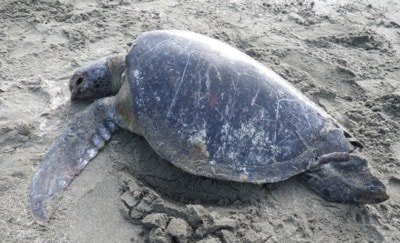A fourth sea turtle – a deceased Green sea turtle, listed as a threatened species by the International Union for Conservation of Nature – washed ashore Pacific Rim National Park Reserve beaches and was discovered by visitors on February 5th. The discovery is part of an extremely unusual trend of sea turtle strandings in the park that may be related to this year’s La Niña. The turtle has been sent off-site for a necropsy.
The sea turtle wasn't the only interesting find at Pacific Rim National Park this month. On Feb. 7 visitors exploring Long Beach noticed enormous bones protruding from the sand. Parks Canada employees helped sift through the sand to reveal a sea lion skeleton. The large ribs, scapula and vertebrae bones can still be seen on Long Beach where the tide will eventually wash them away or cover them again in sand.
In other Pacific Rim news:
As a result of fallen branches during storm season, both Rainforest and Schooner trails will both be closed till March 30th. As these dates could change, visitors are encouraged to visit the Pacific Rim National Park Reserve website for the latest updates.
•••
Electronic trail counters are one way Pacific Rim National ParkReserve betters understands visitor activity and makes management decisions about trails. Unfortunately, several of these counters have gone missing.
Pacific Rim National Park Reserve (PRNPR) is visited by approximately 800,000 visitors annually, which adds up to many people sharing experiences on boardwalks, trails and beaches. Parks Canada is trying to determine which trails are the busiest within the Long Beach Unit of PRNPR and, what implications the level of use may have for wildlife management and visitor experience. To assist with human-wildlife management small infrared counters have been set up by Parks Canada to help determine the number of people using trails within the Long Beach Unit.
The use of Infrared trail counters has been implemented in many of Canada’s National Parks. The counters record anonymous data. No type of still image or video image is recorded. An anonymous time stamp can be used to formulate a general overview of when hikers are using the trails and whether they are alone or in groups. Trail monitoring is one management tool that Parks Canada uses to enable us to enhance the PRNPR experience to both local residents and visitors.
The WildCoast Project, initiated by Parks Canada, began from a growing concern of increased conflict between humans and predators, primarily cougar and wolves, in the west-coast region. Growing reports of observations and encounters on park trails initiated new and innovative measures to enhance the safety of both trail users and animals. The infrared counters are part of this project, helping Parks Canada trace the pattern of trail use throughout the Long Beach Unit.
If you come across one of these hidden counters, please pass by and enjoy your walk. Your assistance will help ensure that we have accurate data collection. If you have any questions or would like to know more about the trail monitoring, or would be interested in volunteering, please contact the Park Office at 250-726-3500.
(Trail counters information provided by Olivia Bancroft)
